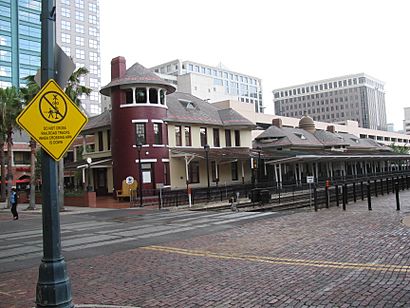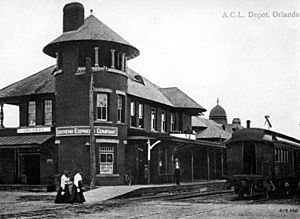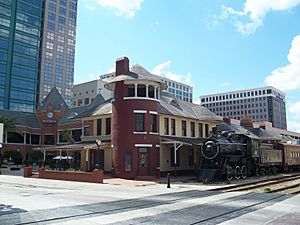Church Street Station facts for kids
Quick facts for kids
Church Street Station SunRail commuter rail station
|
|||||||||||
|---|---|---|---|---|---|---|---|---|---|---|---|

The Old Orlando Railroad Depot built in 1889 still stands alongside the modern SunRail station
|
|||||||||||
| Location | 4 Depot Place, Orlando, Florida | ||||||||||
| Coordinates | 28°32′24″N 81°22′50″W / 28.54°N 81.380556°W | ||||||||||
| Owned by | Florida Department of Transportation | ||||||||||
| Platforms | 2 side platforms | ||||||||||
| Tracks | 2 | ||||||||||
| Connections | |||||||||||
| Construction | |||||||||||
| Structure type | At-grade | ||||||||||
| Parking | Street and garage parking | ||||||||||
| Bicycle facilities | Yes | ||||||||||
| Disabled access | Yes | ||||||||||
| Other information | |||||||||||
| Fare zone | Orange | ||||||||||
| History | |||||||||||
| Opened | 1889 | ||||||||||
| Rebuilt | 2013 | ||||||||||
| Traffic | |||||||||||
| Passengers (FY2018) | 95,524 (annual) |
||||||||||
| Services | |||||||||||
|
|||||||||||
|
Old Orlando Railroad Depot
|
|||||||||||
| Built | 1889 | ||||||||||
| Architect | T. B. Cotter | ||||||||||
| Architectural style | Eclectic Victorian, Shingle Style | ||||||||||
| NRHP reference No. | 76000604 | ||||||||||
| Added to NRHP | 22 April 1976 | ||||||||||
Church Street Station, also known as the Old Orlando Railroad Depot, is a historic train station in Orlando, Florida. It is also a fun place with shops and entertainment. The old train depot and nearby buildings now hold a retail and entertainment center. This spot is also a stop for SunRail, which is a train service for people traveling around the Greater Orlando area.
The station building was built in 1889 by the South Florida Railroad. It served many different train companies until 1926. After that, passenger trains moved to what is now the Orlando Health/Amtrak station. In the 1970s, the station and nearby buildings were bought. They were then turned into a popular entertainment center.
Contents
Discover Church Street Station
The Historic Train Station
The original station was built in 1889 by the South Florida Railroad. It was made to serve the city of Orlando. The South Florida Railroad later became part of the Plant System in 1893. Then, in 1902, the Atlantic Coast Line Railroad took over. The station also served other train lines like the Tavares, Orlando and Atlantic Railroad.
In 1926, passenger trains started using a new station. But the Church Street depot is still standing today. It is listed on the National Register of Historic Places. This means it is an important historical site.
SunRail: Modern Commuter Trains
The SunRail commuter train project uses the historic Church Street Rail Depot. It is one of three stops in downtown Orlando. A new platform was built near the old station. It is just a short walk from Orlando City Hall.
Church Street Station is like most SunRail stations. It has white poles supporting green roofs. You can find ticket machines, emergency call boxes, and drinking fountains. There are also special platforms for passengers using wheelchairs. The station is on the old CSX A-Line tracks. It is easy to get to many places from here. These include the Dr. Phillips Center for the Performing Arts and Orlando City Stadium. It is also close to the Amway Center, home of the Orlando Magic NBA team.
Fun and Entertainment Complex
A businessman named Bob Snow opened Rosie O'Grady's Good Time Emporium in 1974. It was a huge success in the 1970s and 1980s. This place let people visit many different nightclubs for one price. It was a popular spot for "club hopping."
Church Street Station's Golden Age
The entertainment complex started in the old 1904 Hotel Orlando building. It grew to cover both sides of Church Street. It even included the Old Orlando Railroad Depot. At one point, it was the fourth largest attraction in Florida. Some people said it had more visitors each year than almost anywhere else in Florida.
Bob Snow sold his part of the business in 1989. Other big theme parks like Walt Disney World and Universal Studios Orlando later opened similar entertainment areas.
One very popular spot was the Cheyenne Saloon and Opera House. It looked like an old western saloon. This three-story building had a bar, restaurant, and live shows. Famous Country music artists like Garth Brooks and Alan Jackson performed there. This was before they became big stars.
Rosie O'Grady's Flying Circus offered hot air balloon rides. From the sky, you could see downtown Orlando. You could even see the nearby Cape Canaveral Space Force Station.
Changes Over Time
Over the years, Church Street Station faced challenges. Other entertainment places opened, which meant fewer visitors came. The complex tried to add more shops in 1985, but it didn't bring back the crowds.
The property changed owners several times. Each new owner tried to bring back the fun and excitement of the past. In 1994, a large event space called the Presidential Ballroom was built. It was popular for parties and meetings.
In 2001, a local company bought Church Street Station. They closed some of the older attractions.
Later, a businessman named Lou Pearlman became involved with the property. His company's offices were at Church Street Station. In 2007, his offices were searched by federal agents. His belongings were later sold at an auction at Church Street Station.
The 21st Century: New Beginnings
In 2007, Bob Snow, the original founder, returned with other investors. They planned to make the area lively again. The Cheyenne Saloon & Opera House reopened in 2008.
In 2010, the former Rosie O’ Grady's building was sold. The new owners planned to open a New Orleans-style restaurant and bar.
In 2013, Mark Ferguson bought the property. He opened a dining and entertainment spot called Ferg's Depot in 2017. It had a dining room, a sports bar, and an oyster bar. The restaurant also turned into a nightclub at night. This business closed in 2018.
Trains Return and New Plans
Passenger train service came back to Church Street Station in 2014. This was when SunRail started its commuter rail service. A New Orleans-themed event venue, The Orchid Garden, was also renovated in 2014.
In 2017, Lincoln Property bought most of the Church Street Station property. They have big plans for redeveloping the area.
Today, the area around Church Street Station is busy. There are many restaurants, bars, and event spaces. You can also find high-rise apartments and condos. The Amway Center, a large entertainment arena, is also nearby. It opened in 2010 and is home to the Orlando Magic NBA team. In 2019, a local tour company planned to open an office and a bar with live music at the station.
Timeline of Church Street Station
- 1889: The station building is built by the South Florida Railroad.
- 1926: Passenger train service stops at the station.
- 1972: Businessman Bob Snow announces plans for a fun entertainment complex in downtown Orlando.
- 1974: Snow opens Rosie O'Grady's.
- 1976: The station is added to the National Register of Historic Places.
- 1982: The Cheyenne Saloon & Opera House opens.
- 1985: Church Street Station attracts 1.7 million visitors. It becomes the fourth-largest tourist spot in Florida.
- 1989: Bob Snow sells his remaining part of Church Street Station.
- 1994: Church Street Station adds a large Presidential Ballroom for events.
- 1999: A British company buys Church Street Station.
- 2001: A local real estate company buys Church Street Station.
- 2002: Lou Pearlman becomes involved with Church Street Station.
- 2007: Pearlman's offices at the station are seized.
- 2007: Cameron Kuhn buys Church Street Station at an auction.
- 2008: Some parts of Church Street Station reopen, including The Cheyenne Saloon.
- 2010: The historic train locomotive, Frisco 0-6-0 Switcher #3749, is put up for sale.
- 2012: The historic locomotive is moved to the Florida Railroad Museum.
- 2013: St. Petersburg businessman Mark Ferguson signs a lease for the property.
- 2014: SunRail commuter train service begins at a new platform next to the original station.
- 2017: Lincoln Properties buys most of the property.





